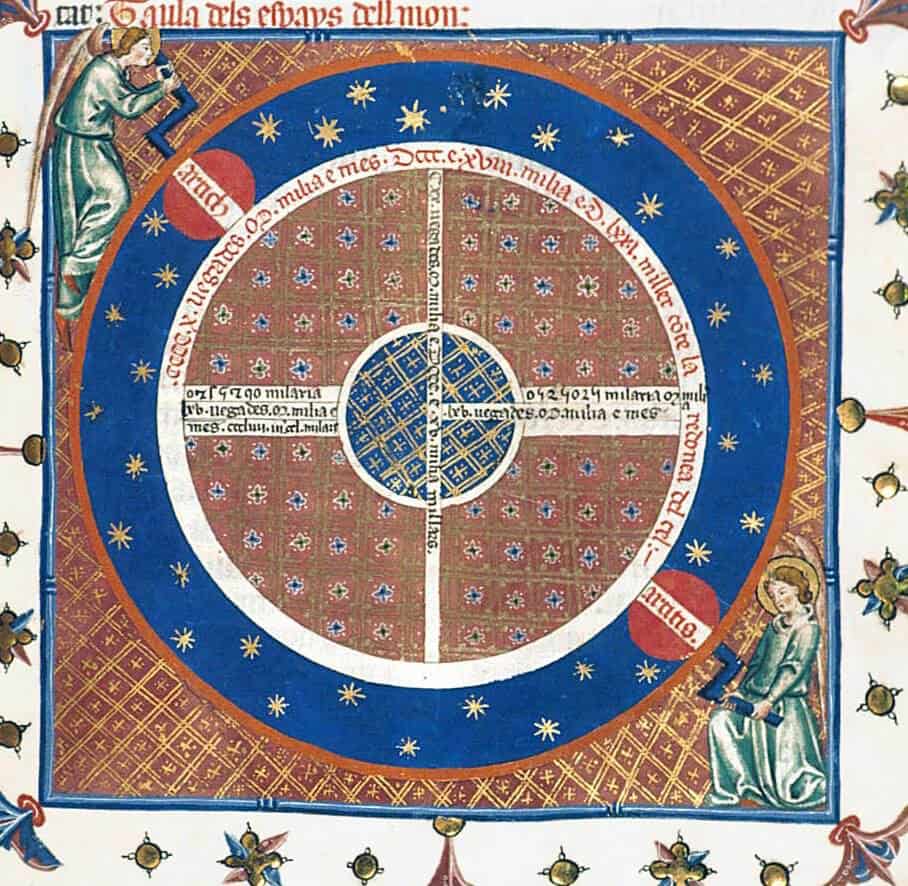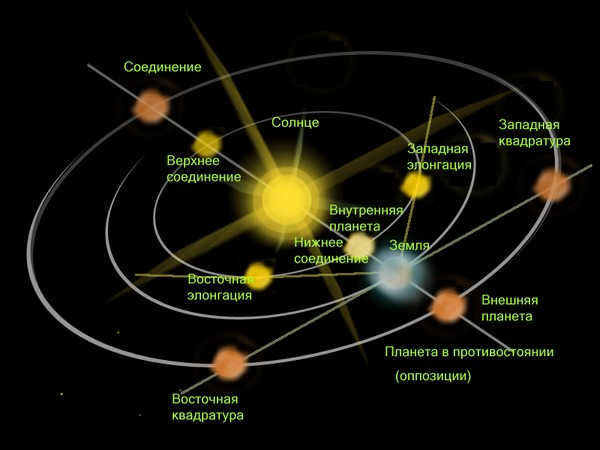
The apparent movements of the Sun and planets across the sky are a reflection of their movements on the celestial sphere. These movements are not directly related to the Earth’s daily rotation, but rather to the rotation of the celestial sphere itself.
Movement of the Sun
The Sun’s motion is nearly uniform (nearly – due to the Earth’s orbit’s eccentricity) along a large circle on the celestial sphere known as the ecliptic, from west to east (opposite to the celestial sphere’s rotation), completing one revolution in a sideric year (365.2564 days). The sideric year differs from the tropical year, which determines the changing of seasons, because of the Earth’s axis precession (refer to Precession of the Equinoxes).
Modification in the equatorial coordinates of the Sun
At the point when the Sun is situated at the vernal equinox, its direct ascension and declination are both zero. As each day passes, the Sun’s direct ascension and declination progressively increase. By the time of the summer solstice, the direct ascension reaches its maximum value of 90° (6 h), while the declination achieves its highest point of +23°26′. Subsequently, the direct ascension continues to rise while the declination decreases, and during the fall equinox, they both have values of 180° (12 h) and 0° respectively. Afterward, the direct ascension keeps on increasing and at the winter solstice, it becomes 270° (18 h), and the declination reaches its minimum value of -23°26′, after which it starts to increase once again.
Depending on the type of movement in the celestial sphere, the planets are categorized into two groups: lower (Mercury, Venus) and upper (all other planets except Earth). This division has been preserved historically, but there are also more modern terms used, namely, inner and outer (in relation to Earth’s orbit) planets.
When the lower planets are visibly in motion, they undergo a change in phase similar to the Moon [1]:34-35. On the other hand, the upper planets, during their apparent motion, do not experience any phase changes and always remain with their illuminated side facing the observer on Earth. If the observer, for instance, the AMS, is located not on Earth but behind Saturn’s orbit, they would be able to witness phase changes not only in Mercury and Venus but also in Earth, Mars, Jupiter, and Saturn.
Movement of the planets closer to the Sun
When it comes to the movement of Mercury and Venus across the sky, they always stay relatively close to the Sun. Mercury usually doesn’t venture farther than 18°-28° from the Sun, while Venus rarely strays beyond 45°-48°. Additionally, these planets can be found on either side of the Sun, either to the east or west. The point at which a planet is farthest to the east of the Sun is referred to as the eastern elongation or evening elongation. On the other hand, the point at which a planet is farthest to the west of the Sun is known as the western elongation or morning elongation.
During eastern elongation, the planet can be seen in the western sky shortly after sunset. It moves from east to west, but in a backward motion. Slowly at first, and then faster, the planet approaches the Sun until it is concealed in its rays. This significant moment is known as the lower conjunction, where the planet passes between the Earth and the Sun. After a period of time, it becomes visible again in the eastern sky just before sunrise. Continuing its lateral movement, it reaches the western elongation, comes to a stop, and begins to move from west to east, in a straight line, catching up with the Sun. Once it catches up with the Sun, the planet once again becomes invisible, marking the upper conjunction, where the Sun is positioned between the Earth and the planet. Continuing its forward motion, the planet once more reaches the eastern elongation, pauses, and begins its backward motion – and so the cycle repeats.
Movement of the planets above
Easily observable from the surface of our planet, the motion of Mars in relation to the celestial stars during the year 2003 was quite remarkable. The sideways trajectory of Mars spanned from July 31 to September 30 [2], creating a fascinating celestial spectacle. Moreover, at the midpoint of this particular arc, precisely on August 28, the much-anticipated Mars (Great) opposition took place [3].
The upper planets exhibit a pattern of both forward and retrograde motion. When an upper planet is visible in the western sky shortly after sunset, it moves across the celestial sphere in a forward motion, following the same path as the Sun. However, the speed at which the planet moves is always slower than that of the Sun, resulting in a conjunction between the planet and the Sun when they align. Once the Sun overtakes the planet, it becomes visible in the eastern sky before sunrise. The planet’s forward motion gradually slows down, eventually coming to a stop and reversing its direction, moving westward among the stars in a retrograde motion. At the midpoint of its retrograde arc, the planet reaches opposition, a position on the celestial sphere directly opposite the Sun. This occurs when the Earth is positioned between the Sun and the planet. After a period of time, the planet stops once again and changes its direction to a forward motion, starting the cycle anew.
Average measurements of the sidereal motions’ arcs
The sidereal arcs of the planets have the following average values: Mercury – 12°, Venus – 16°, Mars – 15°, Jupiter – 10°, Saturn – 7°, Uranus – 4°, Neptune – 3°, Pluto – 2°.
Additional Information
- ↑Vorontsov-Vel’yaminov B.A. Astronomy: Textbook for the 10th grade of secondary school. – 17th ed. – M.: Prosveshchenie, 1987. – 159 p.
- ↑Mars 2003
- ↑August 28, 2003 – recording of Mars’ opposition
| Newton’s Laws of Motion – Law of Universal Gravitation – Kepler’s Laws of Planetary Motion – Two-Body Problem – Three-Body Problem – N-Body Gravity Problem – Bertrand’s Problem – Kepler’s Equation |
| Celestial coordinate systemGalactic – Horizontal – First Equatorial – Second Equatorial – Ecliptic – International Celestial Coordinate System – Spherical Coordinate System – World Axis – Celestial Equator – Direct Ascension – Declination – Ecliptic – Equinox – Solstice – Fundamental Plane. |
| Keplerian orbital elements: Eccentricity – Major semi-axis – Mean anomaly – Longitude of ascending node – Pericenter argument – Apocenter and pericenter – Orbital velocity – Orbital node – Epoch |
| Motion of the Sun and planets on the celestial sphere – Ephemerides Planetary configurations: opposition – quadrature – parade of planets – Culmination – Sidereal period – Orbital resonance – Rotation period – Pre-Eclipse of equinoxes – Synodic period – Convergence Eclipse: solar eclipse – lunar eclipse – saros – Methone cycle – Coverage – Passage – Libration – Elongation – Kozai effect – Yarkovsky effect – Janibekov effect |
| Space velocity: first (circular) – second (parabolic) – third – fourth Tsiolkovsky’s formula – Gravitational maneuver – Goman trajectory – Osculating element method – Tidal acceleration – Change of orbital inclination – Docking – Lagrangian points – Pioneer effect |
| Geostationary orbit – Heliocentric orbit – Geosynchronous orbit – Geocentric orbit – Geo-transition orbit – Low reference orbit – Polar orbit – Tundra orbit – Sun-synchronous orbit – Lightning orbit – Osculating orbit |
When observing the sky without the aid of telescopes or binoculars, planets and stars appear as bright points of light. This raises the question: how can one differentiate a planet from a star in the celestial expanse?
There are various indicators that can assist in making this distinction. Let us examine them.
Stars and Planets: A Dance in the Sky
As you gaze up at the night sky for a few hours, a fascinating phenomenon becomes apparent – the entire expanse of stars gracefully glides from east to west. This celestial ballet, which also includes the sun and moon, occurs over a twenty-four hour period and is a direct reflection of the Earth’s rotation on its axis.
While the stars appear to be in constant motion, their positions in the sky undergo minimal change. These distant celestial bodies are so far away that their movements in space go unnoticed by us. Consequently, the arrangement of constellations has remained unaltered for millennia. This is why astronomers of yore referred to stars as “stationary.”
Stars differ in their movement due to planets! And the movement of the planets closer to the Sun – Mercury and Venus – differs from the movement of the planets further from the Sun – Mars, Jupiter, and Saturn. The planets closer to the Sun are always near it in the sky, and Mars, Jupiter, and Saturn may even appear on the opposite side of the sky from our Sun during the day. Additionally, the outer planets occasionally travel in a loop in the background of the stars, altering their direction of movement..
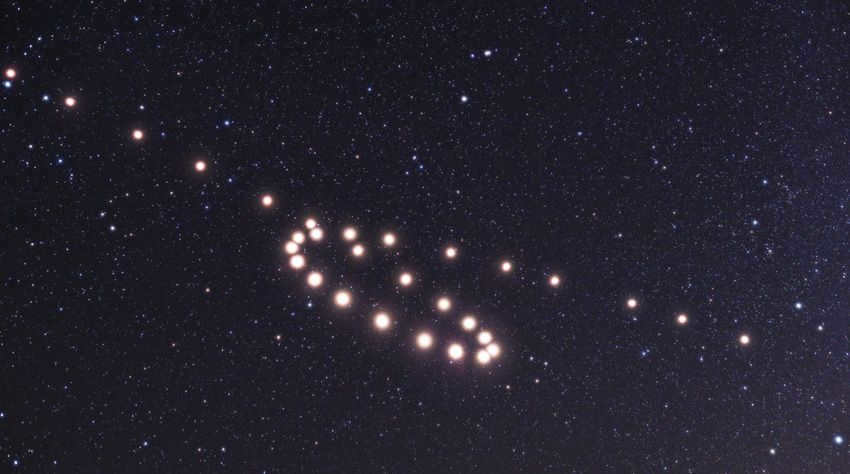
The motion of Mars across the night sky in 2018 was quite interesting. During June of that year, the planet changed its normal eastward trajectory and started moving in a backward motion, creating a loop-like pattern. These images, taken at intervals of 5 to 9 days, beautifully capture this phenomenon. Photo credit: Tunc Tezel/APOD
In order to identify the movement of a planet, it is necessary to observe it for several evenings. This makes it difficult to determine whether the object we are seeing in the sky is a star or a planet. However, if one is familiar with the constellations, it becomes possible to spot an “extra” star within a constellation. If this extra star happens to be particularly bright, it is likely to be a planet.
Movements of Planets in Relation to the Ecliptic
The ecliptic, representing the path of the sun across the constellations, serves as a guide for the planet’s movements. It is essentially a projection of the Earth’s orbit onto the celestial sphere. (Keep in mind that it is the Earth that orbits the Sun.)
As the sun traverses the sky, it passes through specific constellations known as the zodiac. Presently, there are a total of 13 zodiac constellations, including Taurus, Gemini, Cancer, Leo, Virgo, Libra, Scorpio, Serpentine, Sagittarius, Capricorn, Aquarius, Pisces, and Aries.
Due to the fact that the planets follow orbits that are relatively aligned with one another, they too move through the same constellations as the Sun does in our visible sky. (There may be minor exceptions, but they are not significant in this context.) Therefore, it is important to note that planets will not be visible in constellations such as the Big Dipper or the Unicorn. Instead, one should direct their attention to the zodiac constellations in order to spot planets!
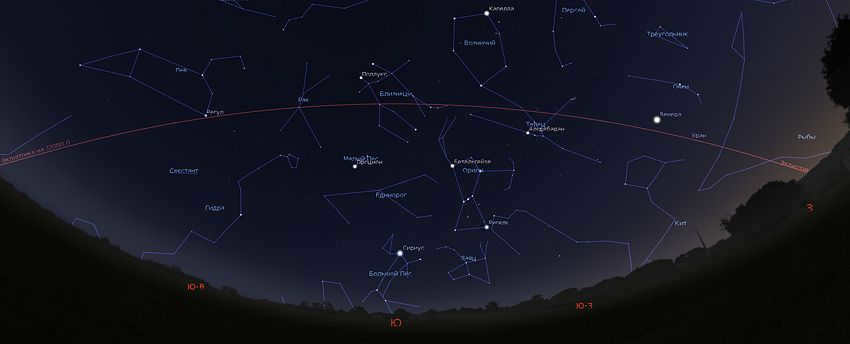
The March 2020 evening sky offers a stunning view. The red arc visible is known as the ecliptic, which represents the Sun’s path against the backdrop of stars throughout the year. It’s worth noting that Venus, seen on the right, is positioned slightly above the ecliptic but still very close to it. (Figure: Stellarium)
Both Venus and Jupiter are considerably brighter than stars, and occasionally Mars too!
Are there any other ways to distinguish between planets and stars?
It’s important not to overlook the fact that Venus and Jupiter are the most luminous objects in our sky! They are only surpassed in brightness by the Sun and Moon. Venus, in particular, emits a dazzling light that can be easily spotted even during daylight hours. At night, its radiance casts distinct shadows on surrounding objects.

The planet Venus was observed in the sky above St. Petersburg in March 2020. The photo was taken by Natalia Danilenko.
Jupiter, although not as bright as Venus, is still much brighter than the stars. Even Sirius, which is the brightest star in the night sky, cannot compare to the brilliance of Venus and Jupiter!
The planet Mars can also be extremely bright (even brighter than Jupiter!), but only for a few months near oppositions.
Mercury and Saturn, on the other hand, are not as impressive. Their brilliance is similar to that of the brightest stars. Mars appears even more modest most of the time – like a second magnitude star. These planets cannot be distinguished from stars based on brightness alone.
The planets emit a steady and serene glow, while the stars shimmer
Have you ever taken notice of the fact that stars typically have an uneven shine? They fluctuate, flicker, and rapidly flare up and down, resembling a candle flame in a gust of wind? This occurrence is known as twinkling. Stars twinkle due to variations in the air that their light traverses. Consequently, the closer a star is to the horizon, the more it twinkles. (When a star is at the horizon, its light passes through the Earth’s denser atmosphere.)
However, the luminous planets – Venus, Jupiter, Saturn, and Mars – barely twinkle at all! They emit a consistent and tranquil glow, akin to a spotlight. This is the most prominent and noticeable distinction between planets and stars.
Why do planets not twinkle?
When we observe stars through a telescope, they appear as mere points of light. However, planets are different – they have distinguishable disks that are visible to the naked eye. Each point on the planet’s disk also exhibits a shimmering effect, alternating between increasing brilliance and weakening. This phenomenon is not limited to individual points, as neighboring points also demonstrate the same behavior. Interestingly, when one part of a planet’s disk becomes brighter, another part may become fainter. Consequently, the combined light emitted from all points on the disk results in a consistent and constant brightness.
The Colors of the Planets
It’s important to remember that each planet has its own distinct color.
Venus is typically white, but can appear yellowish or even orange near the horizon. Jupiter has a yellowish-white color. Saturn is usually a matte yellow or leaden color, although during the years when its rings are fully visible, it can have a more metallic appearance. Mars is generally reddish in color, but can range from a blood red to pink or even orange. The color of Mars depends on various factors such as the time of year, the transparency of the Martian atmosphere, and the size of the polar caps.
Therefore, there are five characteristics that can help us distinguish a planet from a star:
- Planets move among stars.
- Stars do not twinkle; instead, planets shine steadily and quietly.
- Unlike stars, planets like Venus, Jupiter, and sometimes Mars are much brighter. If you see a very bright and evenly shining object, like an airplane searchlight, there is a 99% chance it is a planet.
- The color of the planet can help identify which one it is. Venus appears white, Jupiter and Saturn are yellow, and Mars has a reddish hue. Mercury’s color is difficult to determine as it appears dim against the morning or evening sky. Uranus is hard to see without a telescope, and its color is indistinguishable. Neptune is not visible without optical aid.
On our website, you can discover the planet you are observing by checking out the articles in the “Observer’s Calendar” section.


Currently, 58,741 educational institutions have the opportunity to benefit from additional cumulative discounts ranging from 2% to 25%. To determine the specific discount applicable to all staff members at your educational institution, please access your personal Infoworks account.




Professional course for retraining
Methodological support for the pedagogical process in the implementation of FSES
We can offer a discount for your educational institution in addition to this discount (the amount depends on how many of your colleagues have completed Infowork courses).
Currently, there are additional cumulative discounts (ranging from 2% to 25%) available to 58,741 educational institutions. To find out which discount applies to all employees of your educational institution, please log in to your personal Infoworks account.


Professional growth program
Legal assistance for professional work in the field of education
Additionally, we can apply your educational organization’s discount (the amount depends on the number of your colleagues who have completed Infoworks courses).
Currently, 58,741 educational institutions are eligible for extra discounts (ranging from 2% to 25%). To determine the specific discount available to all staff members of your educational institution, please log in to your personal Infoworks account.


Teaching Children at Home. Tips and Tricks for Parents
Overview of the Presentation by Each Slide:

During a period exceeding 2,000 years before the birth of Christ, individuals made an observation that several stars exhibited movement in the celestial sphere. The Greeks later coined the term “wandering” to describe these celestial bodies, which are now known as planets.

On a daily basis, we observe the Sun emerging from the horizon in the eastern portion of the sky. Subsequently, it steadily ascends above the horizon and reaches its zenith at midday. Following this, it gradually descends, drawing closer to the horizon, and eventually sets in the western region of the sky.

Slide 3: Throughout history, individuals who have observed the Sun’s journey across the celestial sphere have noticed that its elevation at noon changes throughout the year.
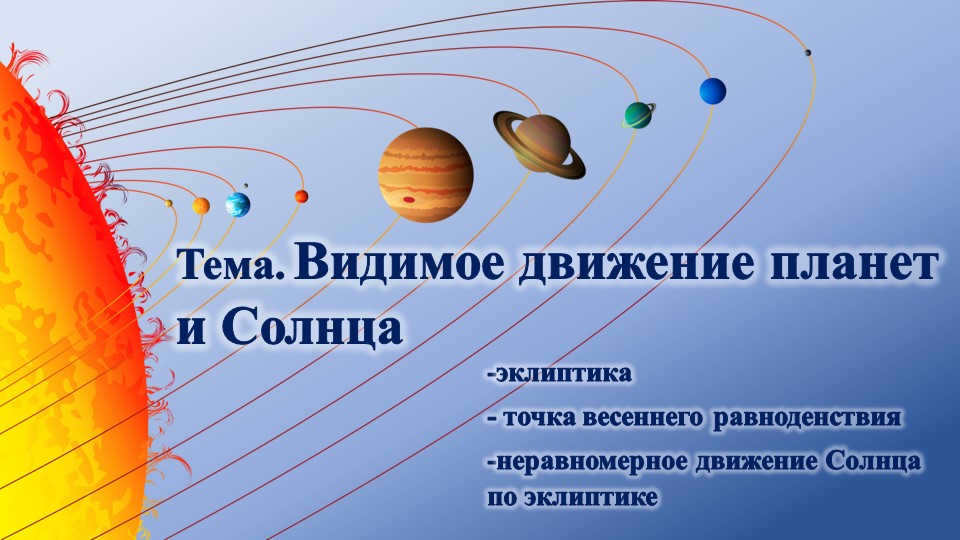
Slide number 4 is about the observable movement of the planets and the Sun. It discusses topics such as the ecliptic, which is the path the Sun appears to follow across the sky, and the vernal equinox, which is the point at which the Sun crosses the celestial equator. Additionally, it covers the consistent motion of the Sun along the ecliptic.
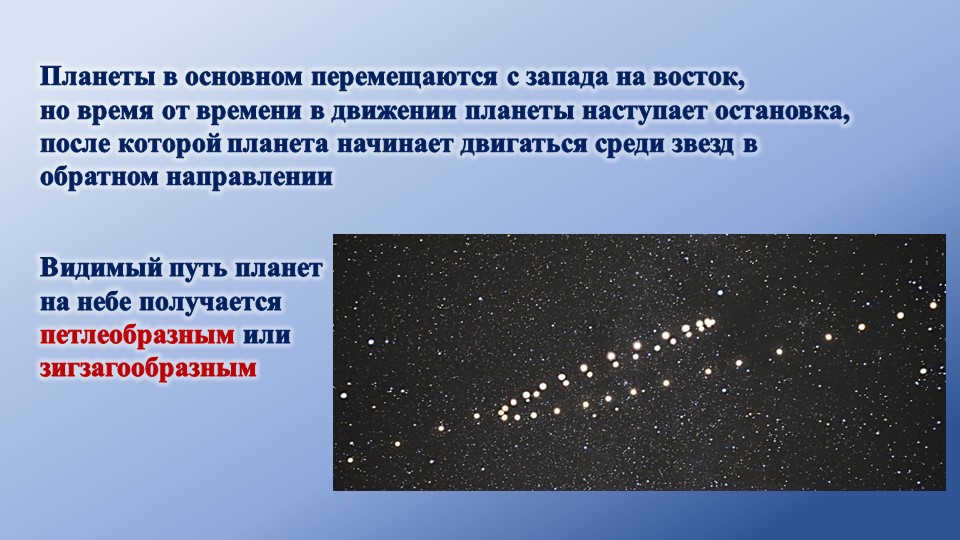

Slide 5: Normally, the planets move from west to east. However, there are instances when a planet temporarily stops and starts moving in the opposite direction among the stars. This results in a loop or zigzag pattern in the visible path of the planets in the sky.
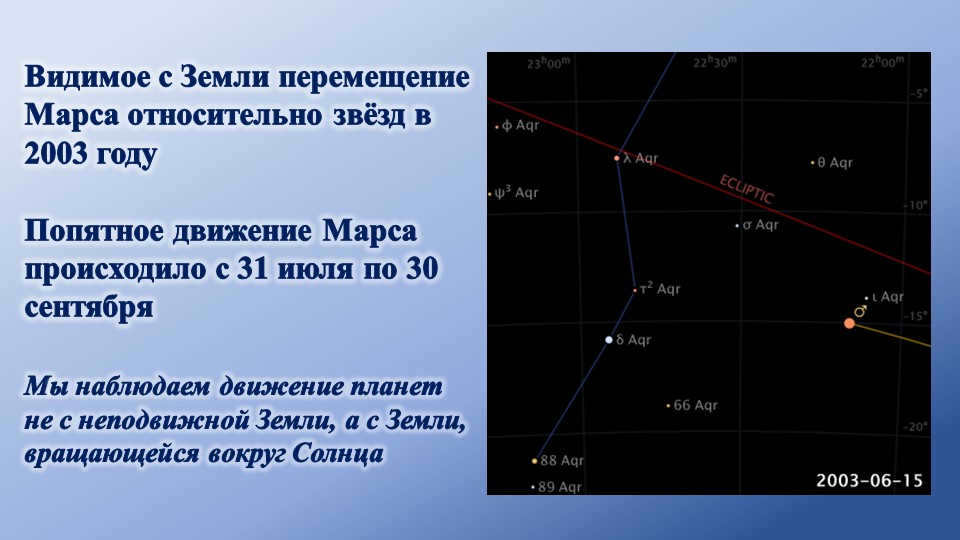
In 2003, Mars, which is visible from Earth, exhibited a noticeable movement relative to the stars.
From July 31 to September 30, there was a sideways motion of Mars. This motion is observed not from a stationary Earth, but from the Earth revolving around the Sun.
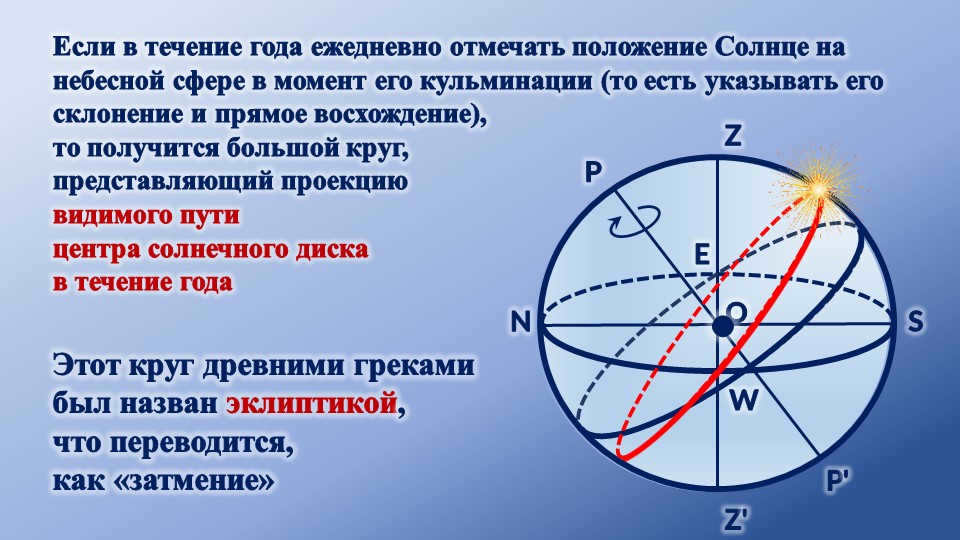

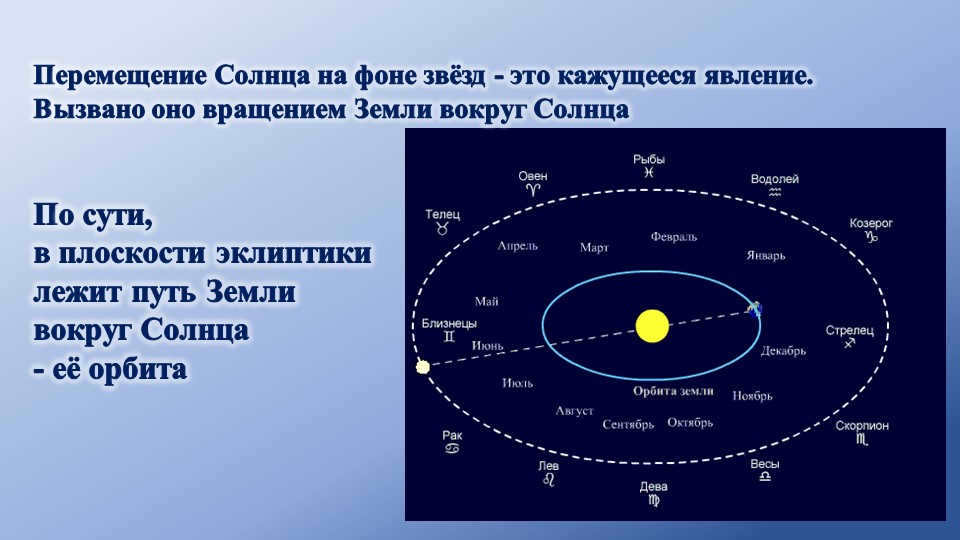

Slide 8: The Sun’s movement against the backdrop of the stars is an observable event.
It is a result of the Earth revolving around the Sun.
Essentially,
the Earth’s orbit lies in the ecliptic plane
around the Sun.
– its orbit.
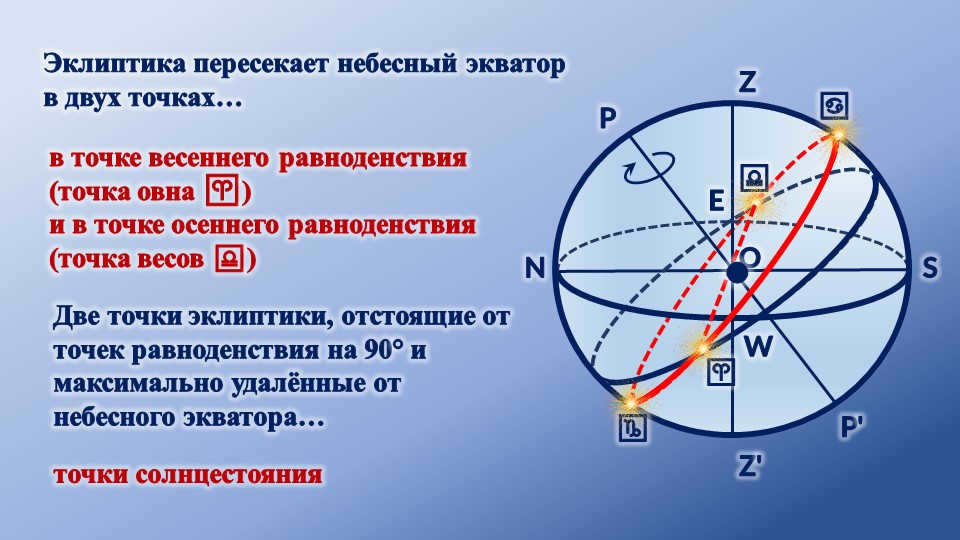

On slide 9 Z’.
Z
O
P’
P
N
S
E
W
♈
♎
♋
♑
•
The path of the sun across the sky is called the ecliptic. It intersects the celestial equator at two specific points…
at the vernal equinox (also known as the point of Aries ♈)
and at the fall equinox.
The two points on the ecliptic that are 90 degrees away from the equinox points and as far from the celestial equator as possible are…
solstice points
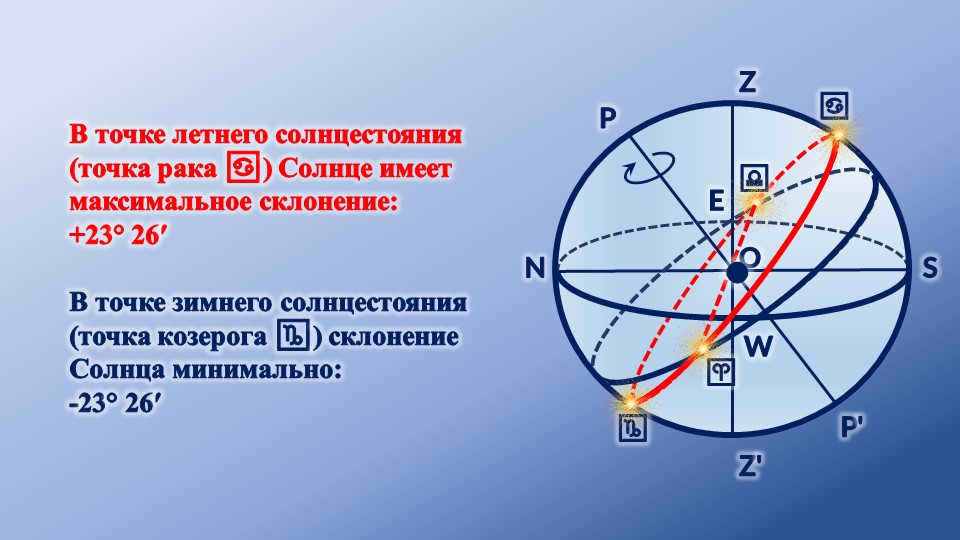
10 slides Z’
Z
O
P’
P
N
S
E
W
♈
♎
♋
♑
•
During the summer solstice, the Sun reaches its highest declination at the point of Cancer ♋, with a declination of +23° 26′.
During the winter solstice at the Capricorn point ♑, the Sun’s declination is at its lowest: -23° 26′.
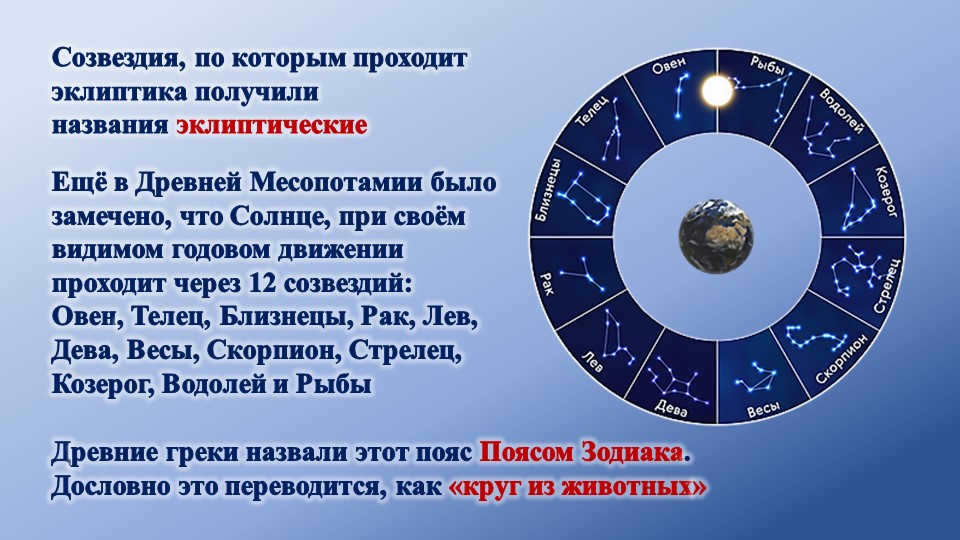

Slide 11: The group of constellations that the ecliptic passes through is commonly known as the ecliptic constellation group.
In ancient times, it was observed that the Sun, during its visible yearly motion, traverses 12 constellations:
Aries, Taurus, Gemini, Cancer, Leo, Virgo, Libra, Scorpio, Sagittarius, Capricorn, Aquarius, and Pisces.
The ancient Greeks referred to this group as the Zodiac Belt.
Its literal translation is “a circle of animals.”
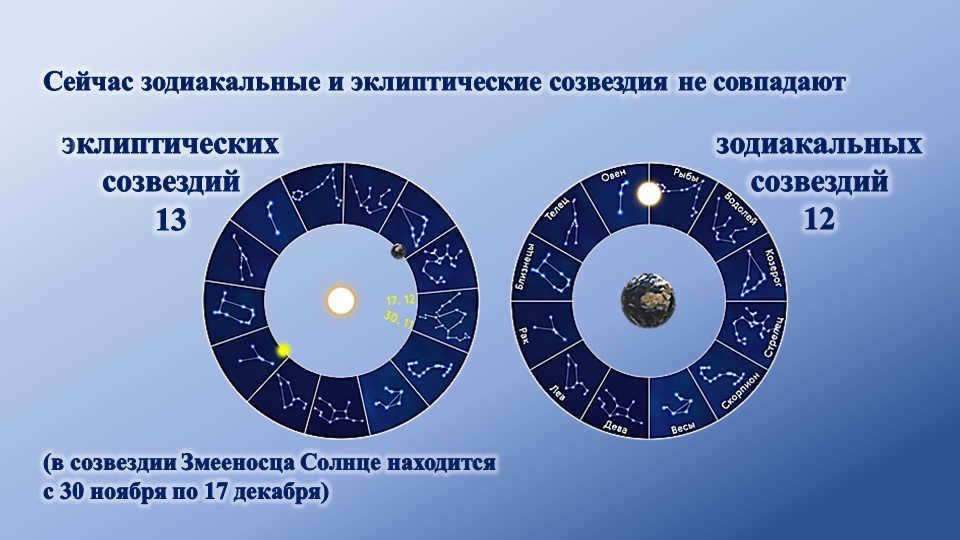

Slide number 12 shows that the zodiacal and ecliptic constellations no longer align.
Specifically, the zodiacal constellations are different than before.
Slide number 12 emphasizes the discrepancy between the zodiacal and ecliptic constellations.
On the other hand, the ecliptic constellations have also changed and are now different from what they used to be.
For example, the Sun is now in the constellation of the Serpentine from November 30 to December 17.
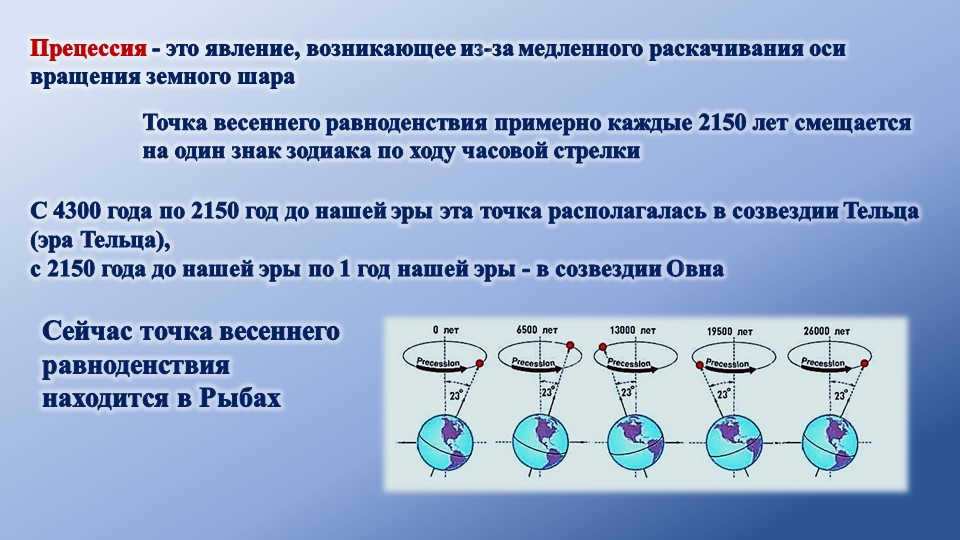
In the 13th slide, we learn about precession, which is caused by the gradual movement of the Earth’s axis of rotation. This phenomenon causes the point of the vernal equinox to shift by one sign of the zodiac in a clockwise direction approximately every 2150 years. During the period from 4300 B.C. to 2150 B.C., the vernal equinox was located in the constellation Taurus, known as the Taurus era. From 2150 B.C. to 1 A.D., it was in the constellation of Aries. Currently, the point of the vernal equinox is in Pisces.
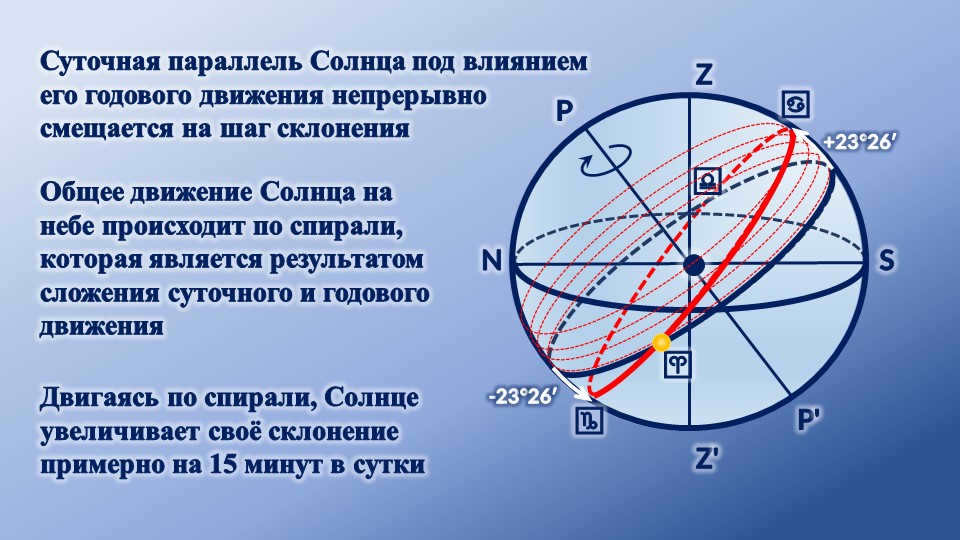
On the 14th slide, the Sun moves in a spiral pattern, gradually increasing its declination by approximately 15 minutes each day. The Sun’s daily parallel, influenced by its yearly motion, continuously shifts by a declination step. The overall movement of the Sun in the sky follows a spiral trajectory, which is the combined result of its daily and yearly motions.
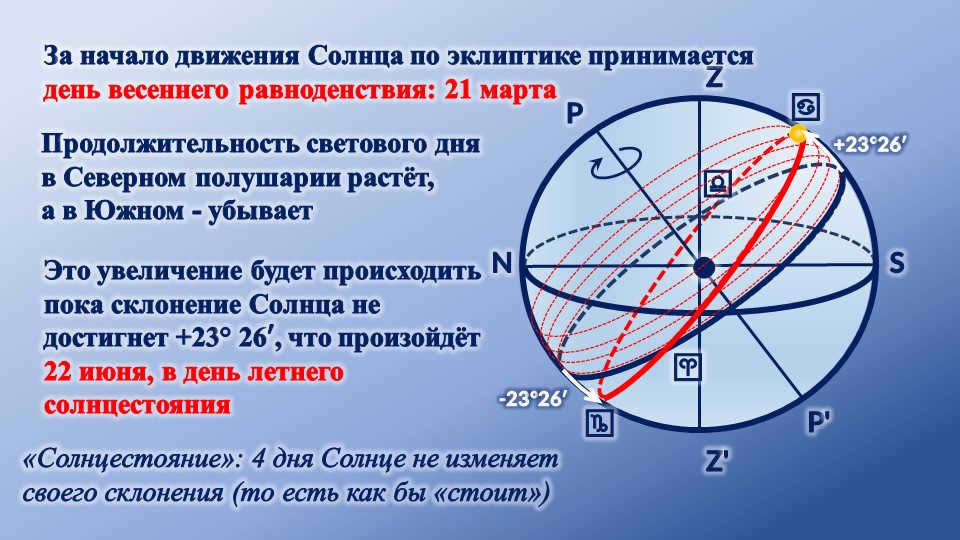

On the 15th slide of the presentation, we can see the symbols Z’, Z, P’, P, N, S, ♈, ♎, ♋, ♑, •, +23°26′, -23°26′. These symbols represent various astronomical phenomena related to the movement of the planets. In the Northern Hemisphere, the length of daylight hours is increasing, while in the Southern Hemisphere, it is decreasing. This change in daylight hours is determined by the Sun’s declination, which is the angle between the Sun’s rays and the plane of the Earth’s equator. The day of the vernal equinox, March 21, marks the beginning of the Sun’s movement along the ecliptic. This movement will continue until the Sun’s declination reaches +23°26′, which will occur on June 22, the day of the summer solstice. During the summer solstice, the Sun reaches its highest point in the sky, resulting in the longest day of the year. The term “solstice” refers to the fact that for 4 days, the Sun’s declination does not change, causing it to appear as if it is “standing still”.
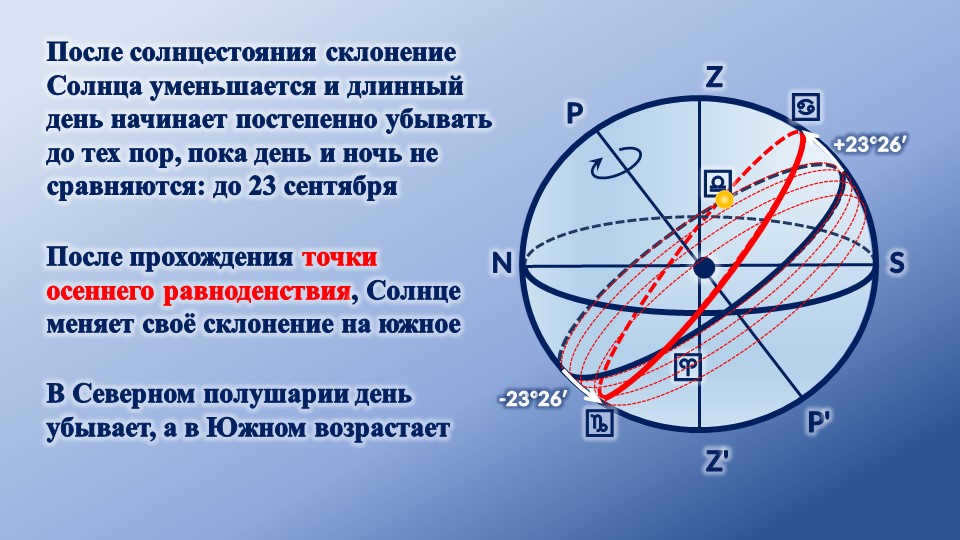

On the 16th slide Z’
Z
P’
P
N
S
♈
♎
♋
♑
•
+23°26′
-23°26′
After crossing the point of the autumn equinox, the Sun’s declination shifts towards the southern hemisphere.
Following the solstice, the Sun’s declination decreases and the length of the day gradually starts to decrease until day and night become equal: until September 23rd.
The length of the day diminishes in the Northern Hemisphere and increases in the Southern Hemisphere.
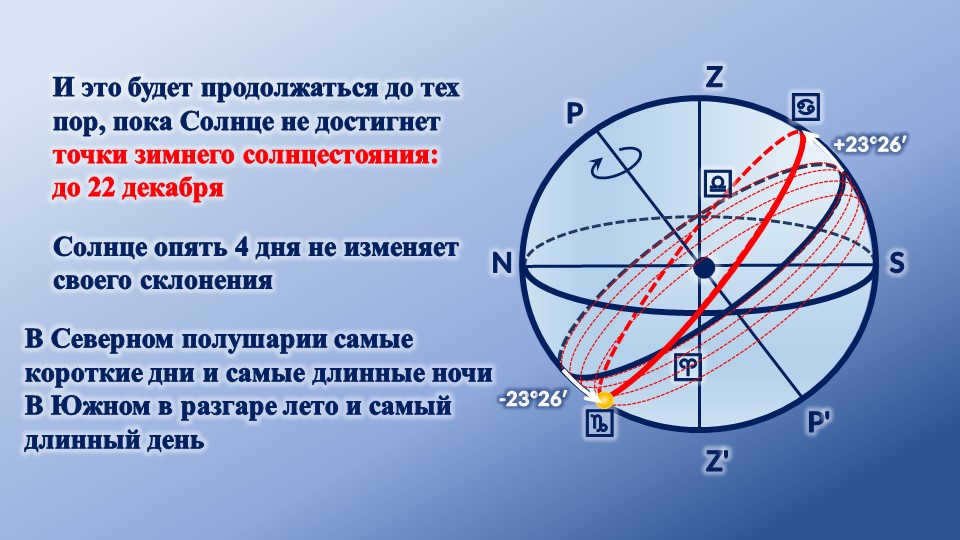
There are 17 slides Z’
Z
P’
P
N
S
♈
♎
♋
♑
•
+23°26′
-23°26′
In the Northern Hemisphere, the days are getting shorter and the nights are getting longer.
In the Southern Hemisphere, it is currently summer and the days are the longest.
This will continue until December 22, when the Sun reaches the winter solstice.
During this time, the Sun remains at the same declination for 4 days.
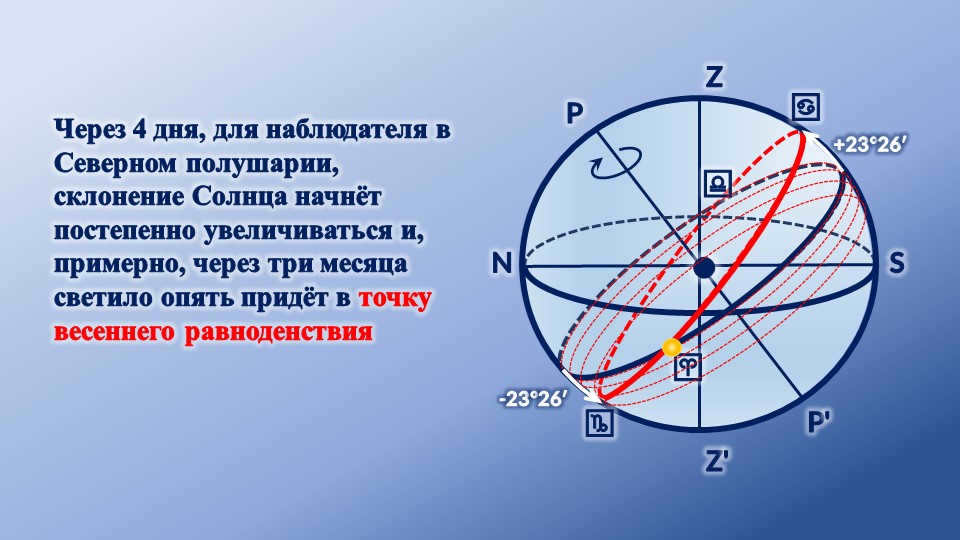
On the 18th slide, the Sun’s declination will gradually increase for an observer in the Northern Hemisphere. After 4 days, the declination will be at Z’
Z
P’
P
N
S
♈
♎
♋
♑
•
+23°26′
-23°26′. This change in declination will continue for about three months until the Sun reaches the vernal equinox point again.
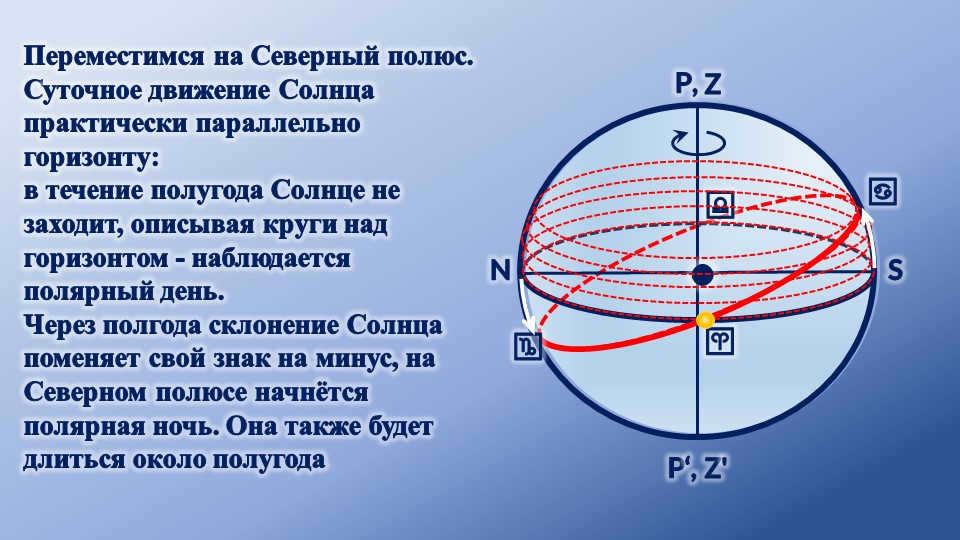
On the 19th slide, let’s consider moving to the North Pole. The Sun’s daily movement is nearly parallel to the horizon: for half a year, the Sun doesn’t set and circles above the horizon, creating a polar day. Then, for the next six months, the Sun’s declination changes sign to minus, marking the beginning of the polar night at the North Pole, which lasts for about six months.
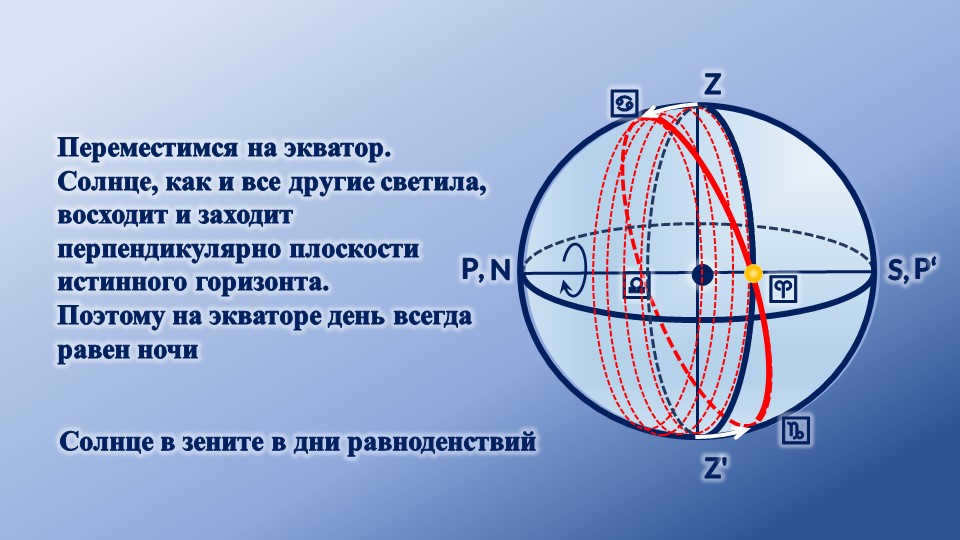

Let’s head to the equator and experience a unique phenomenon. The Sun, along with all the other celestial bodies, moves in a distinctive pattern. At the equator, the Sun rises and sets perpendicular to the true horizon, creating a balance between day and night. This means that at the equator, the duration of day and night is always the same. Additionally, during the equinoxes, the Sun reaches its highest point, known as the zenith. It’s a fascinating sight to witness!
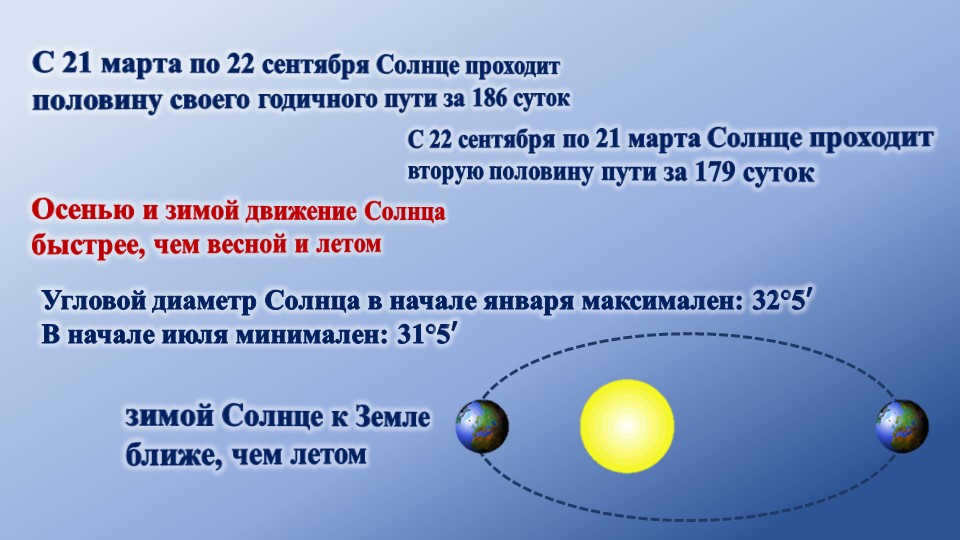

Slide 21: The Sun’s angular diameter is at its maximum in early January: 32°5′.
At the beginning of July, it is at its minimum: 31°5′.
In winter, the Sun is closer to the Earth than in summer.
From March 21 to September 22, the Sun completes half of its annual path in 186 days.
From September 22 to March 21, the Sun completes the second half of its journey in 179 days.
In fall and winter, the Sun moves faster than in spring and summer.
- Evidence for portfolio
- Eternal access for 99 rubles
- 3,800+ video lectures for everyone

Currently, there are 58,741 educational establishments that can benefit from extra discounts ranging from 2% to 25%. To discover the specific discount available for all staff members at your educational institution, please access your personal Infoworks account.




Advanced training program
Supporting the teaching process under the implementation of FSES
We can apply a discount to your educational institution in addition to the current discount (the amount will depend on the number of your colleagues who have completed Infowork courses).
Currently, there are 58,741 eligible educational institutions for additional cumulative discounts (ranging from 2% to 25%). To find out which discount is applicable to all employees of your educational institution, please log in to your personal Infoworks account.




Advanced training program
Legal assistance for professional activities in the field of education
We are able to combine your educational institution’s discount with this offer (depending on the number of your colleagues who have completed Infowork courses).
Presently, a total of 58,741 educational institutions are benefiting from additional discounts (ranging from 2% to 25%). To discover the exact discount applicable to all staff members at your educational institution, please log in to your personal Infoworks account.




Tips for Parents: Homeschooling Made Easy
Breakdown of the Presentation: Slide by Slide

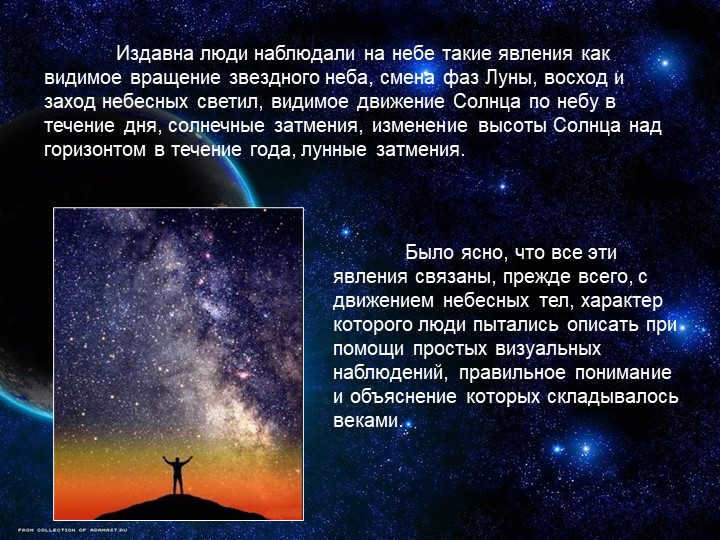
Slide 2: Throughout history, humans have observed various celestial phenomena, such as the apparent rotation of the starry sky, the phases of the Moon, the rising and setting of celestial bodies, the visible movement of the Sun across the sky during the day, solar eclipses, the changing height of the Sun above the horizon throughout the year, and lunar eclipses.
It was evident that all these phenomena were interconnected, primarily linked to the movements of celestial bodies. People attempted to describe these movements through simple visual observations, and over the centuries, they developed a comprehensive understanding and explanation for these phenomena.
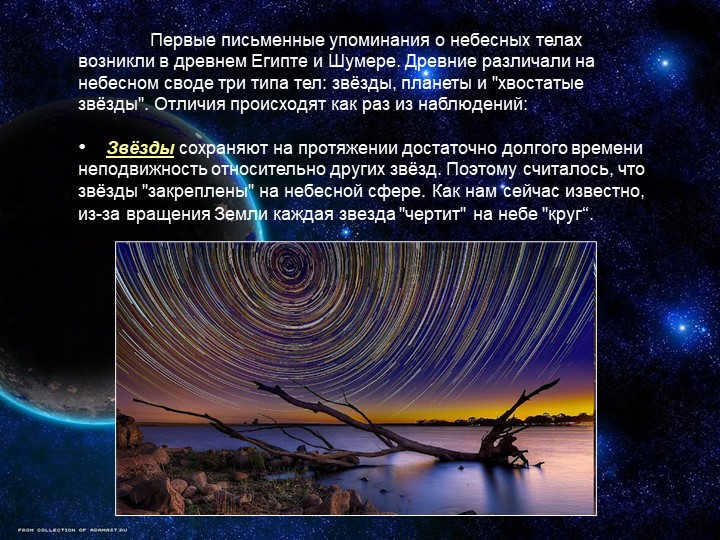

Slide 3: The ancient civilizations of Egypt and Sumer were the first to document celestial bodies. They identified three main types of celestial objects: stars, planets, and “tail stars”. These classifications were based on careful observations:
Stars were believed to be fixed to the celestial sphere because they appeared stationary relative to other stars over long periods of time. However, we now understand that this apparent stillness is due to the rotation of the Earth, which causes each star to trace a circle in the sky.
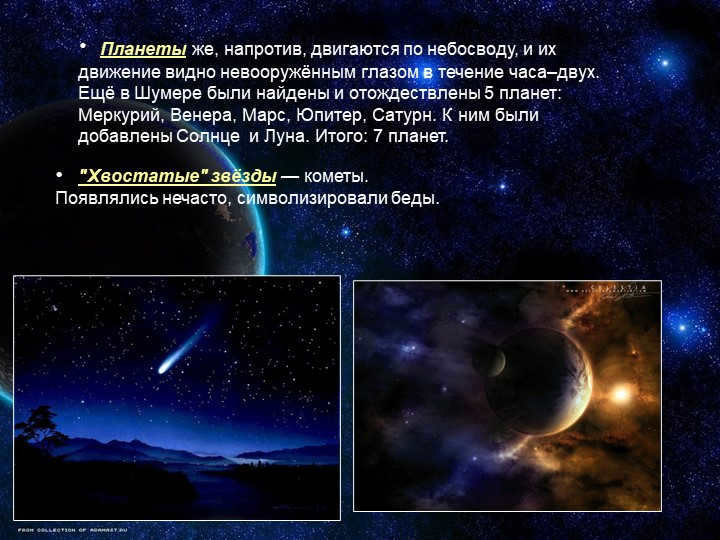

4 Slide The movement of the planets, on the other hand, is visible to the naked eye within a span of one to two hours. In ancient Sumer, they discovered and identified five planets:
Mercury, Venus, Mars, Jupiter, Saturn. Later, the Sun and the Moon were included as well. This totals to 7 planets.
"Comets are stars with tails.
They appear rarely and are associated with bad luck.
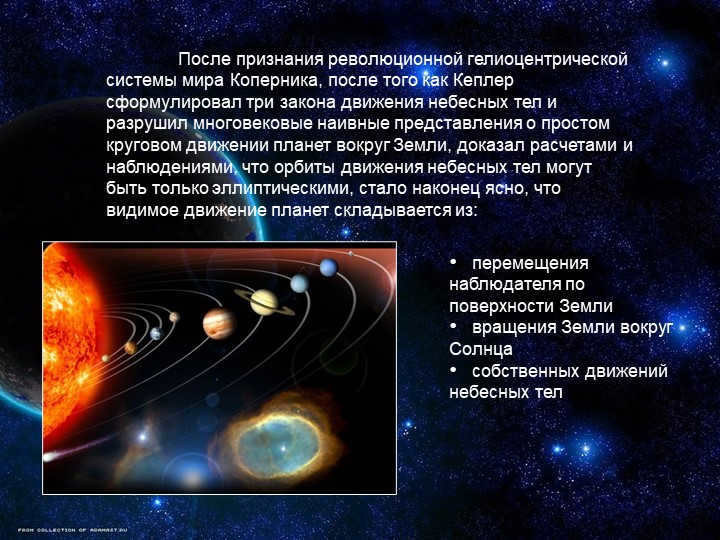

Slide 5 After Copernicus’ revolutionary heliocentric system of the world was accepted, and after Kepler formulated the three laws of motion of celestial bodies, which shattered centuries of naive ideas about the simple circular motion of planets around the Earth, it was proven through calculations and observations that the orbits of celestial bodies can only be elliptical. This finally made it clear that the apparent motion of planets consists of:
– the movement of the observer on the surface of the Earth
– the rotation of the Earth around the Sun
– the proper motions of celestial bodies
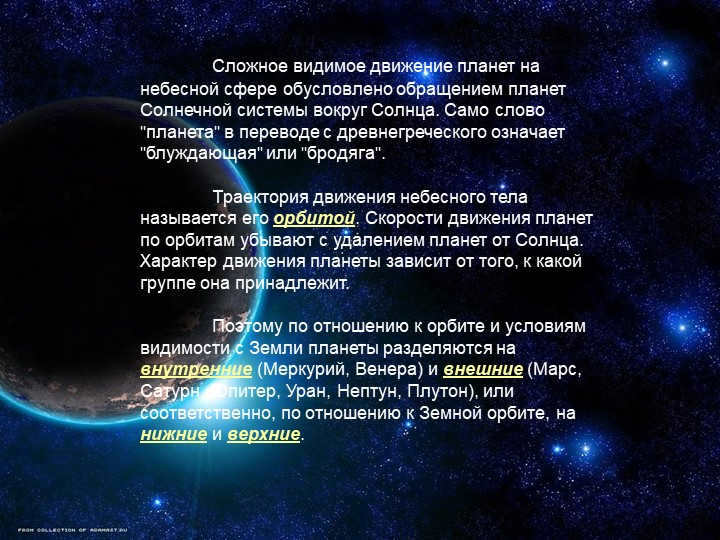
 The path taken by a celestial object is referred to as its orbit. The velocities at which planets move in their orbits decrease as the distance between the planets and the Sun increases. The type of motion displayed by a planet depends on its classification within a specific group.
The path taken by a celestial object is referred to as its orbit. The velocities at which planets move in their orbits decrease as the distance between the planets and the Sun increases. The type of motion displayed by a planet depends on its classification within a specific group.
So, when it comes to the orbit and visibility conditions from Earth, the planets are categorized as either inner planets (Mercury, Venus) or outer planets (Mars, Saturn, Jupiter, Uranus, Neptune, Pluto), or alternatively, lower and upper planets with respect to Earth’s orbit.
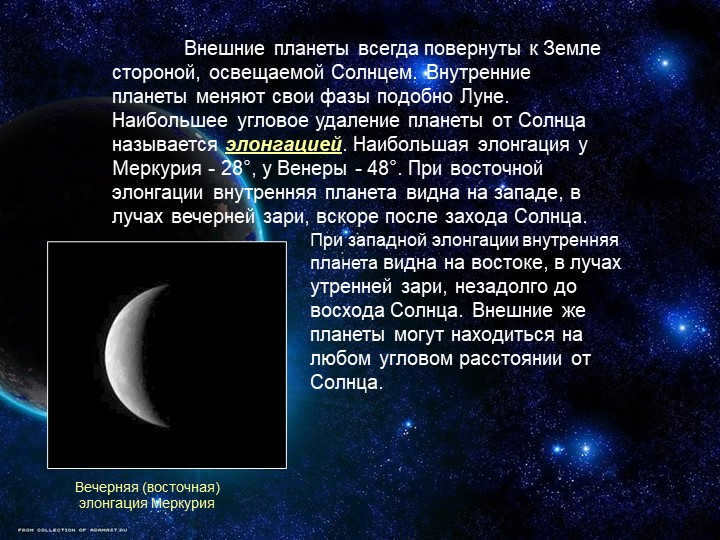
Slide 7: The outer planets are always oriented towards Earth with the side that is illuminated by the Sun. In contrast, the inner planets experience phases similar to the Moon. The maximum angular distance between a planet and the Sun is referred to as elongation. Mercury has the greatest elongation of 28°, while Venus has the greatest elongation of 48°. During eastern elongation, the inner planet becomes visible in the west, illuminated by the evening sunlight, shortly after sunset.
Mercury’s evening (eastern) elongation
During western elongation, the inner planet is visible in the east, illuminated by the morning sunlight, shortly before sunrise. On the other hand, the outer planets can be located at any angular distance from the Sun.
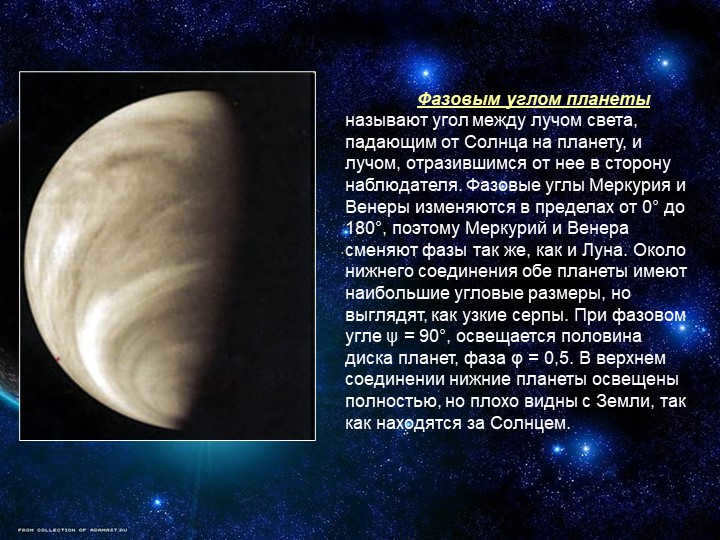
8 slide The phase angle of a planet refers to the angle formed between the sunlight that shines on a planet and the light that is reflected back towards the observer. The phase angles of Mercury and Venus can range from 0 degrees to 180 degrees, causing these planets to go through phases similar to the Moon. During the lower conjunction, both Mercury and Venus appear as thin crescents despite having larger angular sizes. When the phase angle ψ is at 90 degrees, half of the planet’s disk is illuminated, resulting in a phase φ of 0.5. In the upper conjunction, the lower planets are fully illuminated, but their visibility is hindered from Earth due to their position behind the Sun.
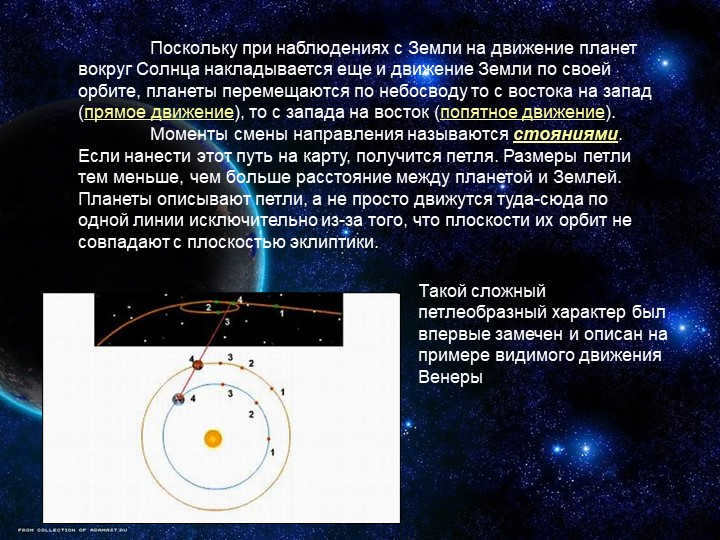
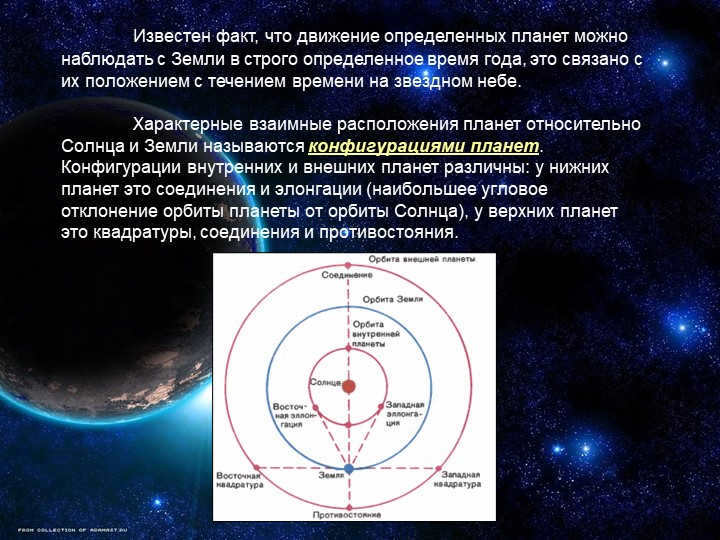
Slide 10: It is a well-known fact that the movement of specific planets can be observed from Earth at specific times of the year. This phenomenon occurs due to the planets’ changing positions in the night sky over time.
The arrangements of planets in relation to the Sun and Earth are referred to as planetary configurations. The configurations differ between inner and outer planets: the inner planets experience conjunctions and elongations (the greatest angular deviation of a planet’s orbit from the Sun’s orbit), while the outer planets have quadratures, conjunctions, and oppositions.
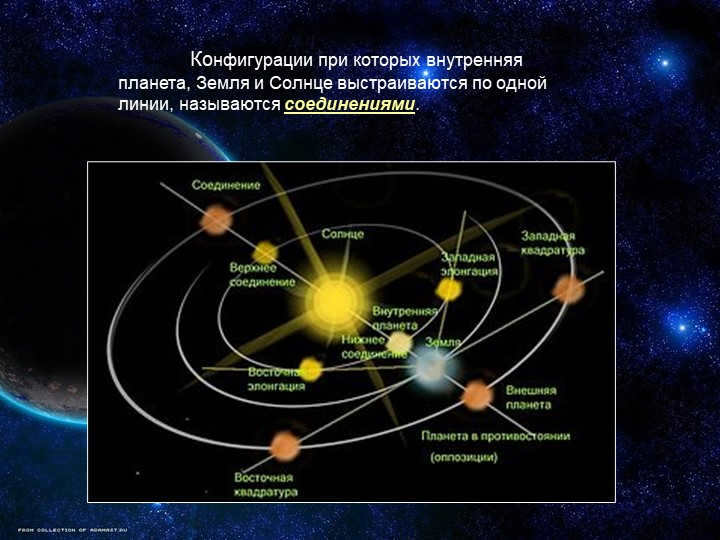
Conjunctions are referred to as the alignments that occur when the inner planet, the Earth, and the Sun are in line with each other.
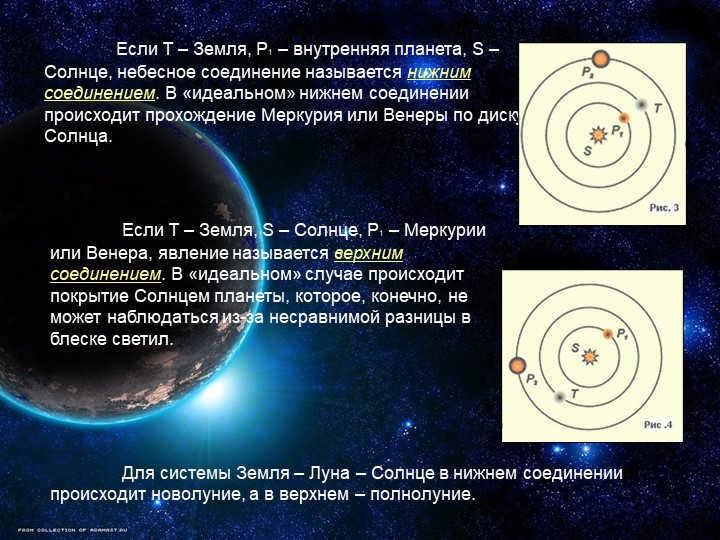
Slide 12: When the Earth (T) is aligned with the inner planets (P1) and the Sun (S), it is known as a lower conjunction. During a “perfect” lower conjunction, either Mercury or Venus passes in front of the Sun’s disk.
If the Earth (T) is aligned with the Sun (S) and either Mercury or Venus (P1), it is referred to as an upper conjunction. In the “ideal” scenario, the Sun completely obscures the planet, although this cannot be observed due to the vast difference in brightness between the two celestial bodies.
In the Earth-Moon-Sun system, a new moon occurs during the lower conjunction, while a full moon occurs during the upper conjunction.
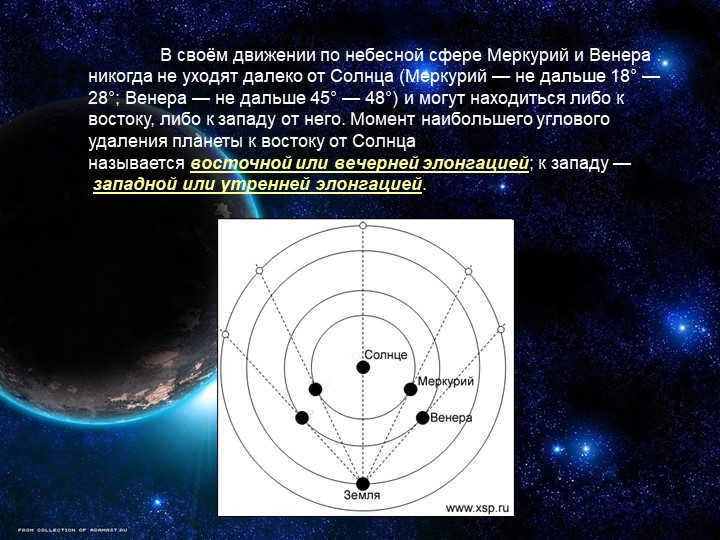

Slide 13 When Mercury and Venus traverse the celestial sphere, they always stay relatively close to the Sun (Mercury – no more than 18° – 28° away; Venus – no more than 45° – 48° away) and can be found either to the east or west of it. The point at which a planet is farthest to the east of the Sun is known as the eastern or evening elongation; when it is farthest to the west, it is called the western or morning elongation.
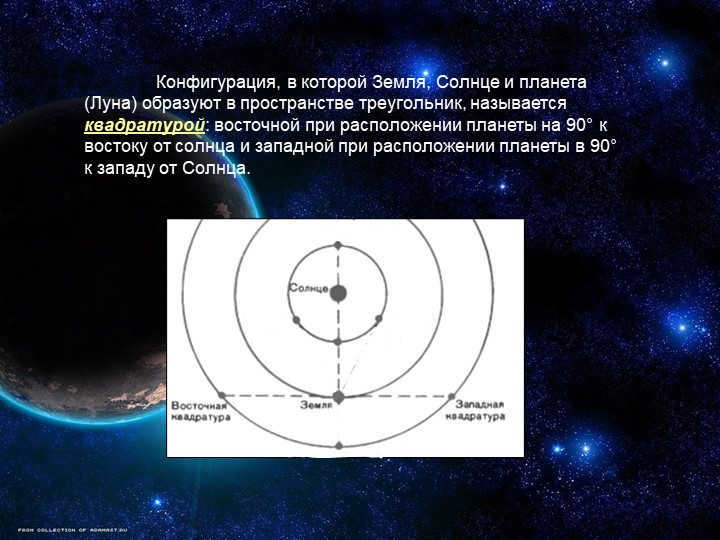

On the 14th slide, the arrangement of the Earth, Sun, and planet (Moon) forming a triangular shape in space is known as a quadrature. It is called eastern quadrature when the planet is positioned 90° east of the Sun, and western quadrature when the planet is positioned 90° west of the Sun.
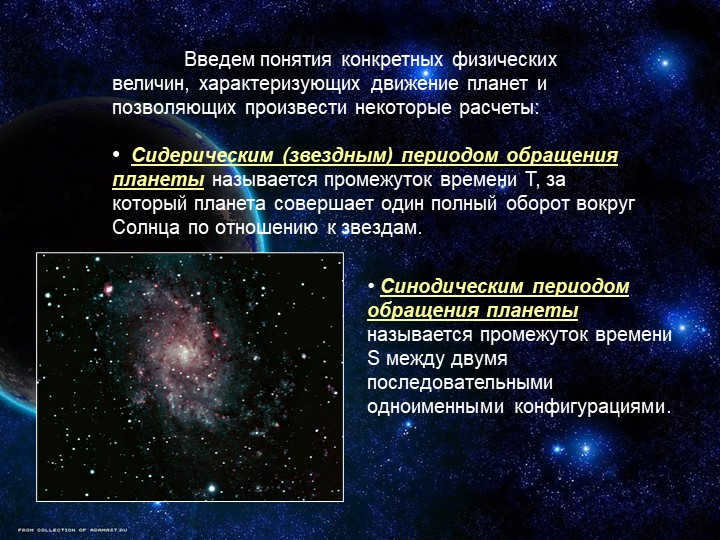
On the 15th slide, we will discuss the ideas of particular physical quantities that describe the movement of the planets and enable us to perform various calculations:
The sidereal period, also known as the sideric period, refers to the time interval T during which a planet completes one full revolution around the Sun in relation to the stars.
The synodic period, on the other hand, represents the time interval S between two consecutive configurations of the same name in a planet’s orbit.
The Milky Way
The Milky Way is a vast wheel-like structure composed of gas, dust, and over 200 billion stars. Interspersed between these stars are billions of miles of empty space. Positioned on the outskirts of this spiral-shaped galaxy is our Sun, creating the impression of a colossal swirling storm of stars when viewed from above. In relation to the immense scale of the Milky Way, our Solar System is incredibly minuscule. To put it into perspective, if we were to liken the Milky Way to the size of Europe, the Solar System would be no larger than a mere walnut.
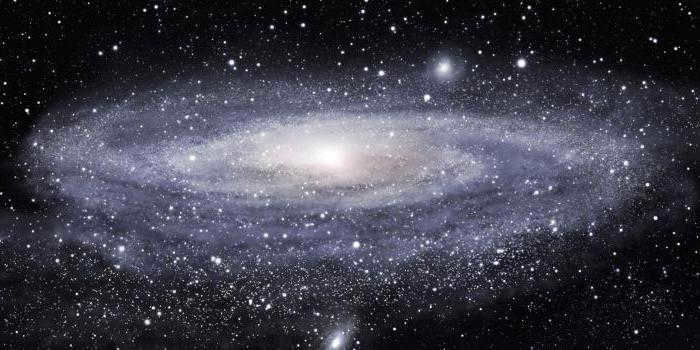
The arrangement of celestial bodies in our solar system
The Sun and its 9 orbiting planets are aligned in a similar direction relative to the center of the galaxy. Just as planets orbit around their respective stars, stars themselves also orbit around galaxies.
It would take approximately 200 million years for the Sun to complete a full revolution around this galactic carousel, traveling at a speed of 588,000 miles per hour. Our Sun is similar to other stars in that it is accompanied by a planet called Earth, which is home to various forms of life. The Sun is also surrounded by other planets and smaller celestial objects known as asteroids.
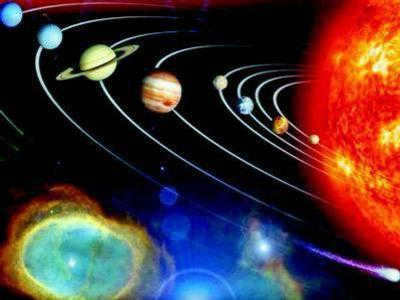
Early observations of celestial objects
For over 10,000 years, humans have been observing the visible movements of celestial bodies and cosmic phenomena. The ancient Egyptians and Sumerians were among the first civilizations to record information about these celestial bodies in their chronicles. The Egyptians were particularly skilled at distinguishing between three types of bodies in the sky: stars, planets, and “stars with tails.” They were also the first to discover and identify Saturn, Jupiter, Mars, Venus, Mercury, the Sun, and the Moon. The visible movements of these celestial bodies refer to their apparent motion as observed from Earth, relative to a coordinate system independent of daily rotation. However, it’s important to note that the real motion of these cosmic bodies is determined by the forces acting on them in outer space.
When you look up at the night sky, you can observe the spiral form of our nearest neighbor, the Andromeda galaxy. In the vast cosmos, the Milky Way is merely one of 100 billion galaxies. Even without the aid of a telescope, you can spot three galaxies, including a part of our own. Two of these galaxies are known as the Large and Small Magellanic Clouds, which were first sighted by the Portuguese explorer Magellan’s expedition in 1519 during their journey through southern waters. These diminutive galaxies orbit around the Milky Way, making them our closest celestial companions.
The third galaxy that can be seen from Earth is Andromeda, located approximately 2 million light-years away. This means that the starlight emitted by Andromeda takes millions of years to reach our planet. As a result, we are observing this galaxy as it appeared 2 million years ago.
Besides these three galaxies, during the nighttime we have the opportunity to observe a portion of the Milky Way, which is comprised of numerous stars. As per the beliefs of the ancient Greeks, this cluster of stars is considered to be the milk originating from the breast of the goddess Hera, thus giving it its name.
Planets that can be seen from Earth
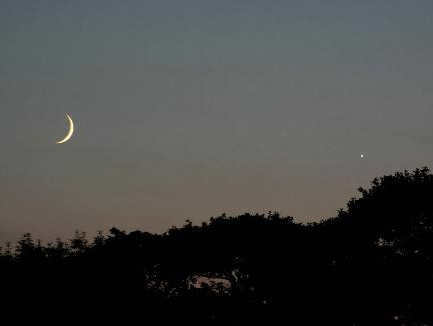
Celestial bodies known as planets orbit the Sun. When we observe Venus shining in the sky, it is because it is being illuminated by the Sun and reflecting some of its light. Venus is referred to as both the Evening Star and the Morning Star, as its position changes throughout the day.
Venus, like other planets, revolves around the Sun and undergoes motion. Throughout the day, we can witness the apparent movement of celestial bodies. The celestial coordinate system not only helps us understand the positions of celestial objects, but also enables us to create star maps, navigate the night sky using constellations, and study the behavior of celestial bodies.
The principles governing the motion of planets
By combining observations and theories on the movement of celestial objects, scientists have been able to uncover the patterns within our galaxy. These findings have allowed for a better understanding of the apparent motions of celestial bodies. One of the earliest sets of astronomical laws to be discovered were Johannes Kepler’s laws of planetary motion.
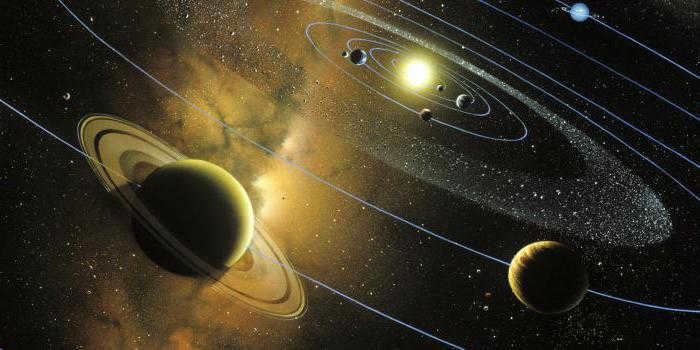
This topic was discovered by a German mathematician and astronomer. After studying the works of Copernicus, Kepler calculated that the best explanation for the apparent movements of celestial bodies is the ellipse. He also formulated Kepler’s laws, which describe the regularities of planetary motion. Two of these laws are particularly relevant to a planet’s movement in its orbit:
- Every planet orbits in an ellipse, with the Sun at one of its focuses.
- Each planet moves in a plane that passes through the center of the Sun, and the radius-vector between the Sun and the planet outlines equal areas in equal time periods.
Lower and Upper Planets
When studying the apparent movements of celestial bodies, physics classifies them into two categories: the lower planets, which consist of Venus and Mercury, and the upper planets, which consist of Saturn, Mars, Jupiter, Neptune, Uranus, and Pluto. These celestial bodies move in different ways within the sphere. The lower planets, similar to the Moon, undergo a phase change during their observed movement. On the other hand, the upper planets always face people with their bright side and do not go through phase changes.
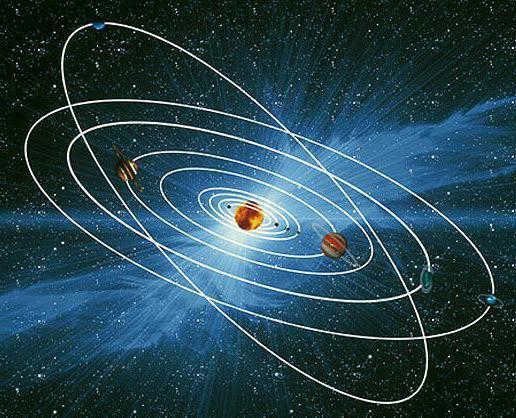
The group of inner planets, including Earth, Mercury, Venus, and Mars, orbit the Sun in inner orbits, in contrast to the larger planets that orbit in outer orbits. A prime example is Mercury, which has a size 20 times smaller than Earth and orbits in an extremely inner orbit around the Sun.
Comets and Meteorites
Within the solar system, in addition to the planets, there are numerous comets – blocks of ice composed of frozen gases, small rocks, and dust. These comets orbit the Sun and can be observed when they come close to it. As they approach the Sun, their tail ignites and emits a sparkling glow in the heavens.
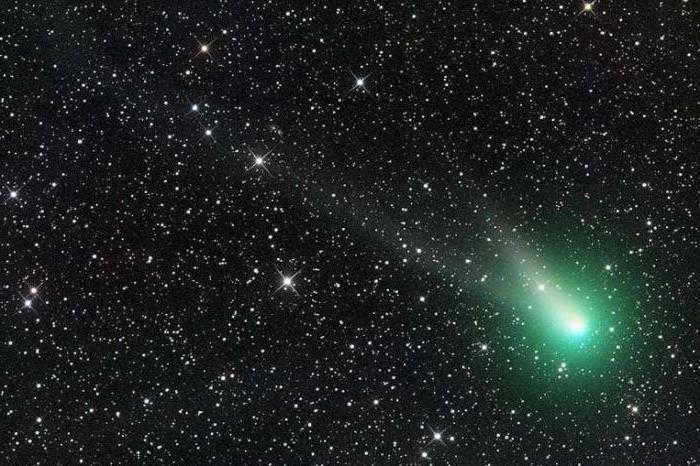
One of the most well-known celestial bodies that exhibits this phenomenon is Halley’s Comet. Approximately every 76 years, it deviates from its usual path and approaches the Sun. During this time, it becomes visible from Earth. Additionally, the night sky offers the opportunity to witness shooting stars, which are actually clusters of matter traveling through space at high speeds. When these shooting stars enter the Earth’s gravitational field, they often burn up. Due to their immense velocity and interaction with the Earth’s atmosphere, they become heated and disintegrate into smaller fragments. This process of combustion is observable in the night sky as a luminous streak.

